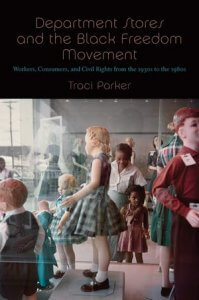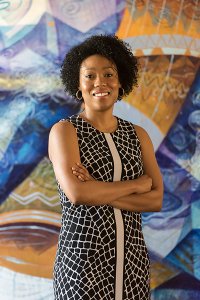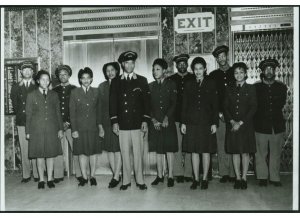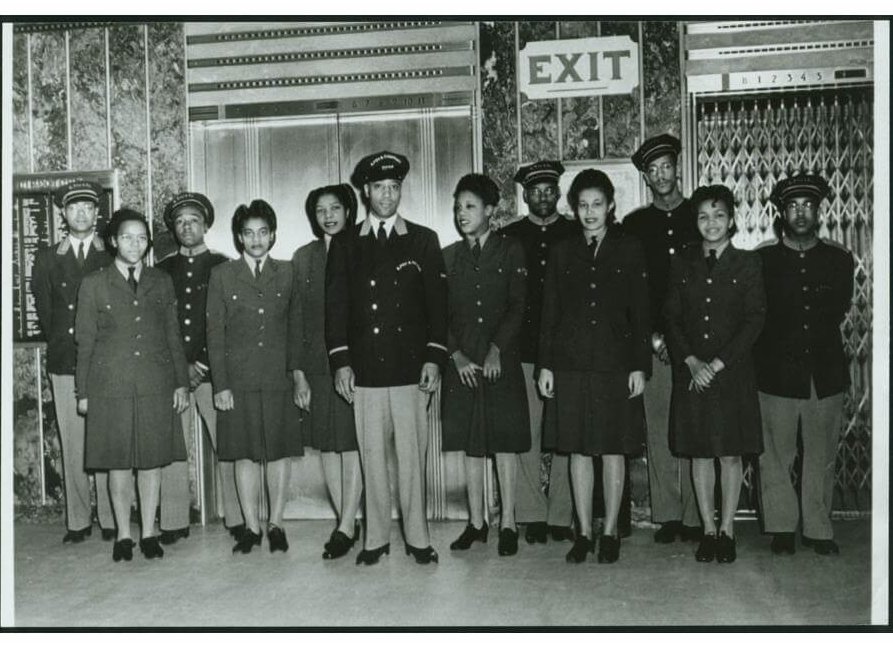Every month or so, LaborOnline interviews the author of a new book in labor and working-class history. This month, our series continues with Traci Parker, whose book Department Stores and the Black Freedom Movement: Workers, Consumers, and Civil Rights from the 1930s to the 1980s was just published by the University of North Carolina Press. Parker, an assistant professor of Afro-American Studies at the University of Massachusetts, Amherst, answered questions from Jacob Remes.
What does special attention to department stores teach us about the Black Freedom Struggle?
Looking at the history of black activism in department stores explains why sites of consumption were key sites of black protest and reveals aspects of the economic dimensions of the civil rights movement.

In the twentieth century, department stores were places to see and be seen in American cities. In many ways, they were markedly different from those that exist today both in their grandness and their efforts to cater to every whim and desire of their clientele. Marshall Field and Company in Chicago, now a Macy’s, for example, was once majestic: its dome ceiling was designed by renowned glass artist Louis Comfort Tiffany (now known as Tiffany & Co.), each corner of the building featured “Great Clocks,” and inside of the store was a large, cast iron fountain called the Burnham Fountain, also known as the “Lost Fountain,” that held 700 gallons of water, and an ornate restaurant with stunning Circassian Walnut paneling and Austrian chandeliers, aptly called the Walnut Room restaurant. Field’s sold high-quality merchandise and premier fashions from across the globe and it did so by providing elite customer services to its patrons.
Department stores also were unlike many other public accommodations such as swimming pools and hotels. They were touted to be democratic spaces in that they welcomed everyone, regardless of race, class, gender, or country of origin, to enter, browse, and purchase and yet simultaneously obeyed the tenets of Jim Crow. In other words, African American customers were provided second-class and uneven service; while African American workers were prohibited from working in skilled jobs in sales, clerical, and management. Instead, African Americans worked as maids, janitors, cooks, and sometimes elevator operators.
It was in this space that African Americans leveraged their labor and purchasing power to highlight the contradictions of American democracy and capitalism. It then makes sense why black protests—notably, the “Don’t Buy Where You Can’t Work” movement in the 1930s and the student sit-movement of the 1960s—often occurred in sites of consumption. Focusing on African Americans’ relationship with department stores also shows how the Civil Rights Movement was an effort on behalf of consumers and workers. It reveals that the movement never abandoned labor and economics, a focus of the black freedom struggle in the 1930s and 1940s, as other scholars have argued; rather activists remained attentive to—albeit more covertly—these issues in the 1950s and 1960s.
Your book stretches over a six-decade stretch, a decade which saw a lot of changes both in civil rights activism and in the retail industry. As department stores changed over the course of the 20th century, how did their role as a site of politics change?

Department stores helped usher in a new form of retailing. During their heyday, department stores were sites of black protest and identity formation. From the 1930s through the 1960s and 1970s, African Americans targeted department stores to end racial discrimination and segregation in labor and consumption. They achieved tremendous success, opening employment traditionally reserved for whites in sales, clerical, and management, dismantling racist customer services practices, and gaining the freedom to try-on and return merchandise, access to store credit, the right to be waited on a first come, first served basis (previously white customers were served first even when a black customer had been in line before them), and patronage at lunch counter, restaurants, and other in-store eating facilities.
By the end of twentieth century, as department stores were displaced as leaders in the retail industry (Wal-Mart assumed this role), they ceased being key sites of black protest. Several factors account for this turn of events. First, as their targeted clientele, white middle-class women, abandoned cities and relocated to the suburbs, department stores followed and anchored suburban shopping malls. These malls were not as easily accessible via public transportation as downtown shopping areas. Too, suburban shopping malls were located on private property, not in downtown centers that were considered public domain. Shopping malls, thus, could prohibit the pickets, demonstrations, and other forms of protest. None of this, I should add, is incidental. Relocating to suburban, private lots of land enabled retailers to dodge any continued protest and to return to their racially discriminatory work and consumer practices.
Second, as Kmart and Wal-Mart cut into their profits, department stores reinvented themselves. They slashed their investments in interior design and ornamentation and personnel, becoming what we know today: retail institutions anchoring suburban shopping centers, packed with racks and racks of merchandise, lacking social elements such as restaurants, tearooms, and lunch counters, like they once did, and serviced by underpaid and unskilled sales workers that function more like cashiers.
By the 1970s and 1980s, then, department stores were a shell of their former selves. Making matters worse was the rise and proliferation of specialty retailers like the Gap and Banana Republic—both of which became the places to shop. Since then, the advent and proliferation of e-commerce—especially Amazon—has cut even more into department stores’ patronage and profits.
What does looking at the Black Freedom Struggle in department stores teach us about class in the Black community?
The department store was arguably a key site for the inception of a modern black middle class. Modern here refers to class identity produced by consumer capitalism, rather than a worker’s status in industrial capitalism.

Since their inception, department stores were a key agent in the formation of the white middle class and promised to do the same for African Americans in the twentieth century. The department store facilitated the growth of professional and white-collar workers in sales, offices, and management; and it served this new population. The store shifted the way Americans saw material goods. It enticed consumers with environments of luxury, desire, exoticism, service ideology, and easy credit, and convinced them that what had been occasional luxuries were in fact everyday necessities for a middle-class standard of living and sharing in American democracy.
For African Americans, the contradictions of the department store provided African Americans with an available and legitimate means to challenge race discrimination in the marketplace and acquire the material base needed to climb the socioeconomic ladder. Leveraging their work consciousness (that flourished as a result of New Deal politics) and new consumer consciousness, black activists built worker-consumer alliances to pressure merchants to adopt fair employment and customer service practices. The result was the making of a sizable contingent of sales and clerical workers of color who now had the freedom and economic means to consume material accouterments and services in department stores that marked them as middle-class citizens.
The department store movement may have succeeded in facilitating the growth of a modern black middle class; but it certainly did not foresee the dramatic decline of these retail institutions. Department store sales and clerical work are now “lower-middle-class jobs” and “dead-end jobs” stripped of their former responsibilities, status, and prestige. Sales workers are cashiers and stock people, for all intents and purposes. Similarly, the nature of consumption has declined—from full-service shopping to self-service shopping. No longer is all merchandise housed in glass cases or out of reach from customers; no longer are sales workers dress in all black or in their Sunday best; no longer are salespeople experts in the art of selling and the merchandise they sold; and no longer are these stores places where visitors have their every desire and whims fulfilled. Now, customers are more knowledgeable about identifying and locating their desired merchandise (in large part because of modern advertising) and are, thus, less reliant on sales clerks to assist them through the shopping experience. Indeed, department stores have lost their prestige and status and thus are no longer key sites of middle-class formation.
Now that you’re done with your book, what books are you looking forward to catching up on?
Wow, there are so many I am excited to delve into. . . . Jennifer Nash’s Black Feminism Reimagined: After Intersectionality, Elizabeth Todd-Breland’s A Political Education: Black Politics and Education Reform in Chicago Since the 1960s, and Lizabeth Cohen’s forthcoming book, Saving America’s Cities: Ed Logue and the Struggle to Renew Urban America in the Suburban Age are at the top of my list. Also, I’m working on a new book project about African American love during the Civil Rights Movement, so I’m really excited to read Sara Rzeszurek’s James and Esther Cooper Jackson: Love and Courage in the Black Freedom Movement, and Stephen M. Ward’s In Love and Struggle: The Revolutionary Lives of James and Grace Lee Boggs. I also can’t wait to re-read James Baldwin’s If Beale Street Could Talk. I know that I am missing a number of other fantastic books that are waiting for me on my bookshelves. . . .







